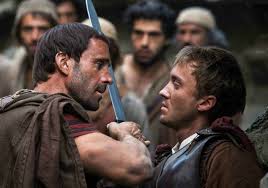(This film review of “Ben-Hur” appeared in the Australian Jewish News on September 1, 2016.)
Directed by Timur Bekmambetov; written by Keith Clarke and John Ridley, based on the novel by Lewis Wallace; and starring Jack Huston, Morgan Freeman, Toby Kebbell, Nazanin Boniadi, Ayelet Zurer, Haluk Bilginer and Rodrigo Santoro.
*****
Certain stories in film and literature can persist for decades, resonating in each retelling or remake. So it is with the latest film version of “Ben-Hur”, the first biblical-style movie epic released since “Exodus – Gods and Kings” and “Noah” both premiered in 2014.
This “Ben-Hur” draws on an impressive historical pedigree, going back to the original 1880 novel, entitled “Ben-Hur: A Tale of the Christ”, by Lewis Wallace, a former Civil War general. This is the fifth screen adaptation of Wallace’s novel: the 1959 version starring Charlton Heston in the lead role won 11 Academy Awards and remains the most vivid in the popular imagination.
This “Ben-Hur” tells the fictional story of Judah Ben-Hur, played by Jack Huston (grandson of legendary film director John Huston and nephew of actress Angelica Huston), a “born to station” Jewish prince living in ancient Israel during the Roman occupation (“33 AD”).
Although a great horseman, Judah lives a soft life in an enormous villa with an extended family, having no apparent work to do other than racing his horses. Judah has an adopted Roman brother, Messala (Toby Kebbell), who has an identity crisis: while welcomed into the Ben-Hur household as a son, he also feels excluded because he is not Jewish.
After an incident where Messala is blamed for Judah’s near-fatal horse-riding accident, Messala runs off to join the Roman legions to fight in “Germania”. Years later he returns to Jerusalem as a senior officer. In the meantime, the “Zealots” have been causing trouble through guerrilla actions against the Romans. Judah opposes this uprising, but faces a conflict. He supports them as individuals but not as a political movement: when asked by the now-Roman officer Messala to identify the Zealots, Judah replies, “I’m not going to name names”, a deliberate reference to the Communist witch-hunts in the USA in the 1950s and Elia Kazan’s “On the Waterfront”.
Judah’s support for an injured Zealot is his undoing, as the man who he shelters attempts to assassinate Pontius Pilate, an act blamed on Judah. This event results in the incarceration of the whole Ben-Hur household, with Judah sentenced to become a “galley slave”, rowing for years in the dank depths of a Roman warship.
Working from a script co-written by John Ridley (“12 Years a Slave”), Russian director Timur Bekmambetov (“Abraham Lincoln; Vampire Hunter”) provides some great action, but is less successful in developing the personal relationships that underpin the story and make us want to care about the characters. These underdeveloped relationships may have resulted because of the film’s duration: the three and a half hours of the Heston version is now cut down to two hours, but still needs to cover a lot of ground.
This latest version of “Ben-Hur” strives for authenticity, nicely shot in the ancient World Heritage centre of Matera in southern Italy, standing in for Jerusalem of Roman times, and the famed Cinecitta studios in Rome. It’s no coincidence that Mel Gibson also filmed “The Passion of the Christ” here.
There are many pleasures in this “Ben-Hur”. The film’s two major set-pieces, the naval battle and the famous chariot race near the end (where Judah and Messala face off), are thrillingly filmed using digital effects that were not available to earlier directors. The addition of Morgan Freeman as a Nubian horse-racer is a total delight, bringing his authoritative personality, mellifluous voice and regal bearing: he has, of course, played both God and the President of the USA in previous films.
This “Ben-Hur” is more avowedly Christian than the Heston film, inserting more scenes of the Jesus figure than its 1959 predecessor, where Jesus’ face was never seen – a particularly effective technique to create mystery. Although the majority of this “Ben-Hur” is straight action-adventure, Jewish viewers are warned: at its heart, “Ben-Hur” is a Christian film, drawing a number of scenes from the Christian Bible books of Matthew, Mark, Luke and John.
This latest “Ben-Hur” also does something new, consciously inserting imagery and action that compares the Roman occupation of ancient Israel with Nazi actions against the Jews. Two scenes stand out. At one point, Roman soldiers desecrate a Jewish graveyard for building materials, stones that we later see with faint Hebrew writing behind Pontius Pilate. And most telling of all, after the attempt on Pontius Pilate’s life, the Romans execute 20 local Jews in retaliation.
*****
A note on the history of “Ben-Hur”: According to the US National Endowment for Humanities, Lewis Wallace’s novel was “the most influential Christian book of the nineteenth century”. For more than 50 years after publication in 1880, it outsold every book in the US except the Bible, until “Gone With the Wind” appeared in 1936; the English language version has never gone out of print. Aside from the 1959 film version with Charlton Heston directed by William Wyler, there have also been two silent film versions (1907 and 1925), as well as a 2003 animated version produced by Heston, who also voiced Judah Ben-Hur’s character. There was also a very popular play in 1899 that even travelled to Sydney and Melbourne, a 2009 London stage version, and a 2010 British-produced TV mini-series.
(below: image for the promotion of a 1901 stage dramatised production of Ben-Hur)




 Posted by donperlgut
Posted by donperlgut 






